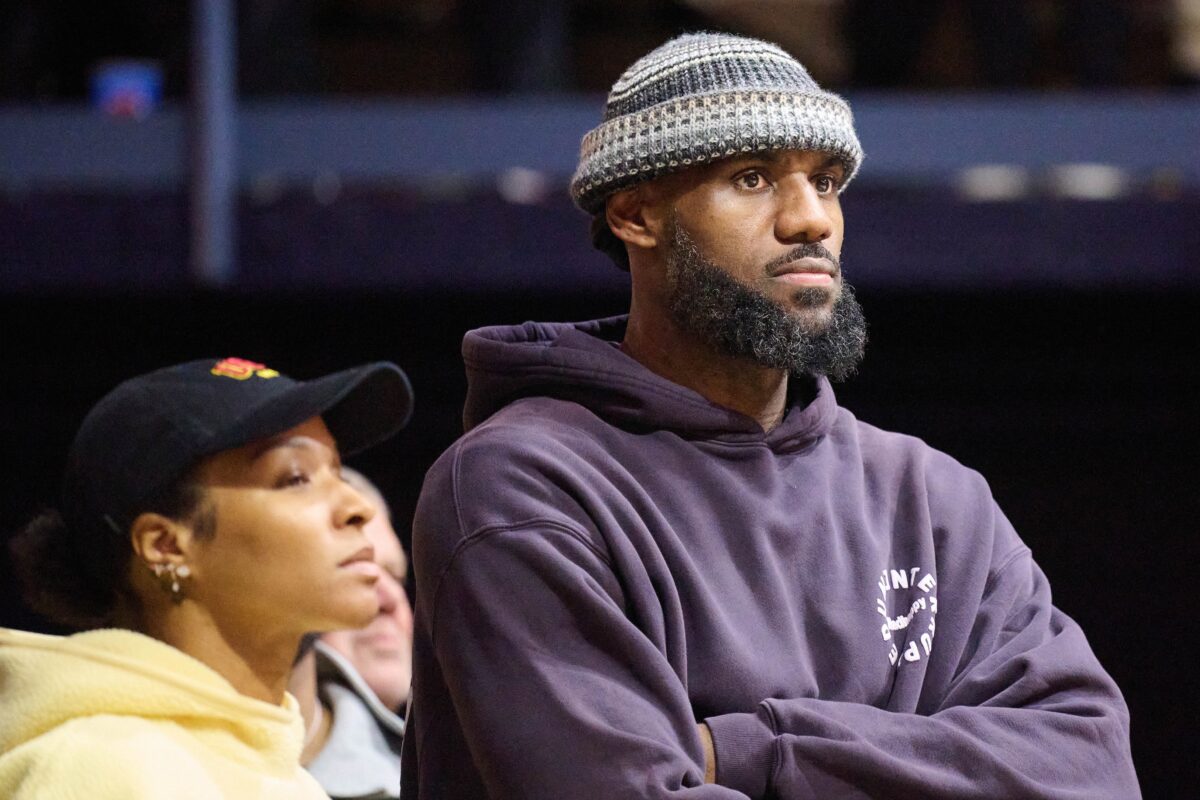Like countless basketball fans around the world, LeBron James is watching both men’s and women’s college basketball tournaments with a close eye.
James, whose son Bronny James played in the NCAA at USC but did not make the tournament, is still tuning into March Madness. The four-time NBA Finals MVP was asked what stands out about the way the style of play in the NCAA.
At first, James talked about the fundamentals of the game on the court. But eventually, he transitioned to discussing the popularity of the game and the way that it is received by the fans.
LeBron James believes the popularity of the women’s NCAA tournament this year compared to the men’s is the “icons” involved in the women’s game. But he pointed out the Catch-22 of those players growing their profile because they’re prevented from being one-and-done. pic.twitter.com/h1VZXhIwd7
— Dave McMenamin (@mcten) April 4, 2024
He highlighted the increasing popularity of NCAA women’s stars such as Angel Reese, JuJu Watkins, Caitlin Clark, Paige Bueckers, and others. All of these individuals, he noted, have become icons in the sport:
“I don’t think there is much difference between the men and women games when it comes to college basketball. I think the popularity comes in is the icon’s they have in the women’s game. You look at Angel Reese, you look at JuJu, you look at Caitlin Clark. You look at Paige.”
These players are fantastic, entertaining, talented, and accomplished on and off the court. They deserve all of the attention they are getting now and will continue to receive in the future.
They will continue to have a massive presence when they turn pro.
“You’re able to build a real iconic legacy at a program and that’s what we all love about it. We love the girl’s game because of that moment … That’s what makes the Final Four and the Elite Eight so great. Iowa was a great team but Caitlin Clark is the reason we tuned in. You’re going to watch Purdue because of Zach Edey because he’s a great player … Players, depending on who they are, will drive the attention when it comes to viewership.”
James went on to compliment the way that the women play the game, discussing the way they pass to their teammates and cut to the basket and dive for loose balls.
But eventually he came back to the way that each of the women that he mentioned above have the ability to really grow their brands while they’re in college. It’s not just star power. It’s staying power.
That means that these storylines develop over the years they play, too, which allows for fans to become invested. That is one of the many reasons why the recent game between Iowa and LSU smashed ESPN’s TV ratings.
More fans watched that than any of the men’s games. James speculated why:
“The star power that we have in the women’s game outweighs some of the men, too … It’s hard to keep up with a lot of the guys because of the transfer portal. Guys are moving. It’s hard to keep up with a certain individual. It’s not the JJ Redick’s where he was there at Duke for four years. Or Shane Battier who came back four years or Miles Simon or Mike Bibby in the late 90s when they was playing.”
It is true that the transfer portal is as busy as ever and that makes it hard for fans to latch on to individual players as their favorites. (There are rumors that LeBron’s son, Bronny, could enter the portal from USC if he does not declare for the 2024 NBA Draft.)
Yet the bigger causation, according to LeBron, is the increased prevalence of the one-and-done prospect pipeline from NCAA men’s college basketball into the NBA.
Many players inevitably decide to turn pro as soon as possible in the NBA. ESPN’s latest projections only have two players with multiple years of college experience (Dalton Knecht and Zach Edey) predicted to hear their names in the lottery of the 2024 NBA Draft.
Because that’s not an option in the WNBA, women’s college basketball has bigger names than men’s.
“It’s just a different time between the men and women and men can come out right after their freshman year. If I have a big [expletive] season after my freshman season of college basketball, I’m going to the league … JuJu, she can’t come out. If she could, you think she might? Maybe. But that’s the difference.”
Watkins, as James noted, is a fascinating example of a player who perhaps would consider declaring for the WNBA Draft even though she has played just one year in the NCAA.
Instead, fans will watch her play several more seasons in college basketball. That’s going to give her multiple years to build her brand and by that time she is 22 years old, her popularity among basketball fans will have plenty of eyes on her whenever she steps on the court.
Ironically, LeBron himself is one of the last prep-to-pro high school draftees in the NBA’s history. Now, even before they are ready to contribute impactful minutes, prospects want to turn pro as fast as possible and will only play one year in the NCAA.
That, however, simply limits how often we truly see stars in men’s college basketball. Women’s college basketball, however, has no shortage of players who have created unmatched legacies for themselves in the collegiate game.
[lawrence-auto-related count=5 category=462925]
